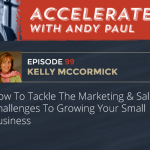 Hi, I’m Kelly McCormick, a Business Growth and Marketing Strategist. I help entrepreneurs & companies to identify opportunities for growth. Plus, I develop targeted branding, marketing & sales strategies. I can help you too!
Hi, I’m Kelly McCormick, a Business Growth and Marketing Strategist. I help entrepreneurs & companies to identify opportunities for growth. Plus, I develop targeted branding, marketing & sales strategies. I can help you too! Kelly McCormick's Business Tips
Recent Posts
How I Avoid Doing A ‘Data Dump’ When Selling
Many of us have sounded like a salesperson at one time or another. You know what I’m talking about. It’s when we blab on about those “Wonderful products and services!”
Please! What customer in their right mind would tell that kind of seller what they really wanted or what the true budget was? Not me.
I wouldn’t trust anyone who tried to sound or even act like a professional seller. This means that there were times when I wouldn’t even buy from myself. What an empowering thought.
Here is how I now avoid doing A ‘Data Dump’ when speaking to clients.
1. Eliminate Paralysis by Analysis
If you spew out pertinent facts and figures at the speed of light, it actually slows the sales process down to a crawl. Many a well-intentioned seller and entrepreneur has been left to wonder what went wrong. “I provided more than enough information,” you rationalize. “The client should have been able to make an informed decision.”
Regrettably, giving all that information was the problem. Wading through a stack of pros and cons can leave a buyer gasping, “Stop, I beg you!” as paralysis by analysis sets in.
2. Use the Less-is-More Approach
Avoid overwhelming your client with details by employing the less-is-more technique. Deliver your information in manageable chunks.
When you speak, simply break your information into smaller pieces. Here’s what this might sound like:
“The X-R-3 model has a turbo-charged motor.”
Take a breath. Now begin again:
“It does the job 10 times faster than the X-R-2 model.”
The less-is-more technique makes it easy for your customer to stay focused on details. It also enables them to process the fine points, one step at a time.
3. Give Your Buyer a Time-Out
It’s not just kids who need a time out; they can be a good thing for buyers, too. Once you deliver your information, give the person some breathing space. Even a few minutes of silence can assist someone in processing what they just heard.
When given the opportunity to digest information, it becomes easier to consider how your solutions will benefit your customer, their family, team, or company. So pause and breathe. Give the person some time to think.
4. Tune-in to Your Buyer’s Wavelength
The only way to know for certain that your proposed solutions were on target is to tune into your buyer’s wavelength.
After you give your prospect a minute or two to mull over your conversation, you need to find out what they’re really thinking. There are several key questions you can ask, including:
• “Is there anything you need clarified?”
• “What else would you like to know?
• “What questions do you have?”
Keep repeating this process until all questions are answered. Bringing all questions out into the open enables a client to reassure themself that your solution(s) will work for them.
5. Listen to Hear “Yes!”
Remember, take the time to deliver your information in bite sized chunks, pause to give the person time to digest what they heard and ask check-in questions to find out what they are really thinking. Then you can breathe a sigh of relief as you hear your new client say, “Yes that’ll work!”
Permission to Reprint – You have my permission to reprint if –
 Hi, I’m Kelly McCormick, a Business Growth and Marketing Strategist. I help entrepreneurs & companies to identify opportunities for growth. Plus, I develop targeted branding, marketing & sales strategies. I can help you too!
Hi, I’m Kelly McCormick, a Business Growth and Marketing Strategist. I help entrepreneurs & companies to identify opportunities for growth. Plus, I develop targeted branding, marketing & sales strategies. I can help you too! 






 Connect Through Social Media
Connect Through Social Media 




I’ve had to sit through some pretty rough sales presentations, but nothing made me want to go on a rampage quite like somebody giving a lecture about specs and system requirements and other bits of raw data.
Great post Kelly!